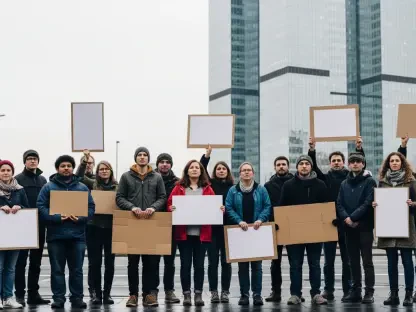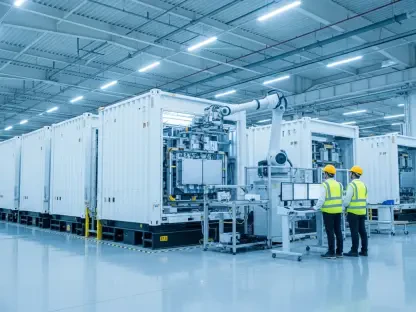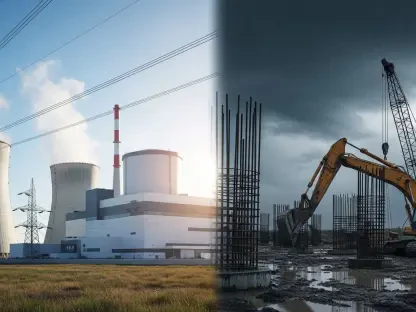The recent regional energy summit in Tanzania brought together African leaders to discuss the critical need for investments to upgrade grid infrastructure and expand modern energy access across the continent. Organized by Mission 300, an initiative by the African Development Bank and the World Bank, the summit aims to provide electricity to 300 million energy-poor Africans by 2030, primarily through renewable energy sources. This ambitious goal reflects the urgent necessity to address the persistent energy access challenges that have long hindered economic and social development in many African nations.
The Need for Modernizing Grid Infrastructure
Addressing Power Outages and Economic Impact
African leaders emphasized the urgent need to modernize aging grid infrastructure to reduce frequent power outages that severely impact economies like Nigeria and South Africa. These interruptions in power supply are often more linked to distribution challenges rather than production capabilities. The frequent power failures not only disrupt daily life but also stifle economic growth by causing significant losses in productivity, affecting businesses and industries alike. In recognition of these issues, the summit placed a strong emphasis on the necessity of robust and reliable electricity distribution systems as foundational to the continent’s economic revitalization. The leaders pointed out that improving grid infrastructure is a crucial step towards mitigating these outages and supporting sustained economic activities. Strategies to achieve this modernization include the incorporation of advanced technological solutions and the deployment of geo-spatial mapping. Geo-spatial mapping can identify ideal areas for both grid and off-grid connections. This technological approach ensures that energy distribution is optimized and tailored to the specific needs of different regions, thus enhancing overall grid stability. By addressing these infrastructural weaknesses, African nations aim to lay down a more dependable foundation for future growth and energy sustainability.
Strategies for Grid Improvement
To tackle these challenges and modernize the grid infrastructure, leaders at the summit discussed a variety of strategic measures. These include the integration of advanced technologies that can improve the efficiency and reliability of energy transmission and distribution systems. Advanced technologies such as smart grids, which use digital communication tools and sensors, can facilitate real-time monitoring and more efficient management of the electricity network. This modernization is essential for reducing losses, improving energy efficiency, and ensuring consistent power supply to end-users. Moreover, the use of geo-spatial mapping has become a critical tool in determining the most effective areas for both grid and off-grid connections. By leveraging geo-spatial data, planners can identify regions where extending the grid is most feasible and where off-grid solutions can provide immediate and effective energy access. This approach not only optimizes resource allocation but also expedites the electrification of underserved areas. Together, these strategies are geared toward stabilizing the grid and enhancing the overall effectiveness of energy distribution systems, paving the way for a more resilient and robust energy infrastructure in Africa.
Embracing Renewable Energy Sources
Diversifying Energy Mixes
The summit underscored the importance of diversifying energy mixes by incorporating renewable energy sources such as solar, hydro, and geothermal power. By expanding their reliance on these sustainable options, African nations can reduce their dependence on fossil fuels, significantly lower greenhouse gas emissions, and enhance overall energy security. This diversification is not only environmentally beneficial but also economically prudent, as renewable energy sources can provide more predictable and often lower-cost power in the long run. Solar energy, in particular, stood out as a pivotal element in this diversification strategy. With its abundant sunshine, Africa is ideally positioned to harness solar power on a large scale. Similarly, hydro and geothermal energy sources, which are already in use in several African countries, offer significant potential for expansion. By collectively investing in a mix of these renewable sources, nations can create a more resilient and sustainable energy system that can withstand fluctuations in any single energy source. This balanced approach ensures a steady and reliable supply of electricity, contributing to the broader goals of economic development and energy sustainability.
Off-Grid Solutions for Rural Electrification
During the summit, off-grid renewable energy solutions, especially solar energy, were heavily promoted as an efficient and economical method to electrify under-served rural communities. Off-grid solutions bypass the need for extensive grid infrastructure, making them particularly suitable for remote areas that are difficult to connect to existing electricity networks. These solutions are expected to play a significant role in achieving the Mission 300 goal, with nearly half of the target anticipated to be met through off-grid connections. The deployment of off-grid solar systems has already demonstrated substantial benefits in rural areas, providing basic yet essential services such as lighting, refrigeration, and mobile phone charging. These services improve quality of life and create opportunities for economic activities that were previously impossible due to the lack of reliable electricity. Moreover, off-grid solutions offer a scalable and swift alternative for electrification, enabling rapid implementation while longer-term grid expansion projects are underway. By adopting these solutions, African nations can make immediate strides toward achieving universal energy access, enhancing rural livelihoods, and fostering inclusive development.
Mobilizing Investments for Energy Development
Public and Private-Sector Contributions
Achieving the ambitious objectives of Mission 300 necessitates significant investments from both public and private sectors. The initial funding target of $40 billion was surpassed, reaching over $50 billion due to contributions from institutions like the Asian Infrastructure Investment Bank (AIIB) and the Islamic Development Bank Group. These substantial financial commitments underscore the global recognition of Africa’s energy crisis and the collective effort required to address it. However, public funding alone is insufficient to meet the continent’s vast energy needs. Private-sector investment plays a crucial role in bridging the funding gap and driving innovation in energy technologies and solutions. Encouraging greater private-sector involvement requires creating investment environments that are conducive to business, with clear regulatory frameworks and policies that mitigate risks and assure investors of returns. African leaders at the summit emphasized the importance of partnership between public authorities and private enterprises to mobilize the necessary resources and expertise for comprehensive energy development.
Creating Attractive Investment Environments
Another pivotal discussion point at the summit was the creation of regulatory frameworks that foster investor confidence and facilitate the development of bankable projects. By implementing policies that reduce investment risks and provide incentives, African nations aim to attract more private-sector capital into the energy sector. These regulatory frameworks may include tax incentives, streamlined permitting processes, and guarantees or protections against political and commercial risks. The summit highlighted examples of countries that have successfully attracted private investment by creating attractive investment environments. These case studies serve as valuable lessons for other nations seeking to enhance their energy infrastructure. For instance, Kenya has been recognized for its robust regulatory framework that has successfully attracted significant private investments in its renewable energy projects, particularly in the solar and wind sectors. By adopting similar measures, other African countries can catalyze private-sector engagement and drive forward their energy development agendas, ensuring sustainable and inclusive growth.
Showcasing National Energy Plans
Detailed Compacts from 12 Countries
Twelve countries presented their detailed energy plans at the summit, with each detailing their unique challenges and strategies for renewing their energy systems. These plans underscored the outdated infrastructure that many countries struggle with and the proactive steps being taken to modernize and expand their energy networks. For example, Zambia emphasized the need for a diversified energy mix to enhance energy security and reduce reliance on hydroelectric power alone, which is vulnerable to climate variability. Nigeria, on the other hand, highlighted the critical need to upgrade its transmission system to address inefficiencies and ensure reliable power distribution across the nation. These compacts reflect a shared commitment to overcoming historical obstacles and advancing toward modern, sustainable energy paradigms. They also illustrate the varied approaches that different countries are taking based on their specific circumstances and resources. By sharing these plans, countries can learn from each other’s experiences and tailor strategies that are best suited to their own needs. This collaborative approach fosters a sense of unity and shared purpose in tackling the continent’s energy challenges, reinforcing the collective goal of Mission 300.
Successful Initiatives and Case Studies
The summit also brought attention to successful initiatives in countries like Uganda, showcasing that significant grid improvements are achievable with adequate support and strategic planning. Uganda has made remarkable strides in enhancing its energy infrastructure, particularly in expanding access to electricity in rural areas. These initiatives include leveraging both on-grid and off-grid solutions to maximize reach and impact. Uganda’s experience demonstrates the importance of a multifaceted approach that combines grid expansion, renewable energy integration, and community-based initiatives to achieve comprehensive electrification goals. These case studies serve as models for other nations to emulate. The success stories highlight the effectiveness of well-coordinated efforts that align government policy, financial investment, and community engagement. By learning from these experiences, other African countries can adopt best practices and avoid common pitfalls, accelerating their own progress toward enhanced energy access. The summit reinforced the notion that with the right strategies and collaborations, significant advancements in energy infrastructure and access are within reach for all African nations.
Collaborative Efforts for Sustainable Energy
The summit underscored the crucial role of collaborative efforts involving government agencies, development banks, and philanthropic foundations in driving sustainable energy development. Development banks such as the African Development Bank and the World Bank provide vital financing and technical assistance to support large-scale energy projects. These institutions often act as catalysts, leveraging their resources to attract additional funding from private investors and other international partners. By offering favorable loan terms and guarantees, development banks help mitigate risks and make energy projects more attractive to private-sector participants. Philanthropic foundations also play a significant role by funding innovative pilot projects and community-based initiatives. These foundations often focus on high-impact interventions that can be scaled up with additional support. For example, initiatives that promote the productive use of electricity, such as powering agricultural equipment or small-scale industries, can substantially enhance the economic prospects of rural communities. By fostering these collaborations, African nations can pilot effective models that synergize public and private contributions, paving the way for a sustainable and inclusive energy future.
Enhancing Quality of Life through Electrification
Off-grid solar energy solutions have proven to be particularly beneficial in rural areas, transforming lives by providing essential services and improving the overall quality of life. Access to reliable electricity enables better healthcare services through powered medical equipment and refrigeration for vaccines. It also enhances educational opportunities by allowing students to study at night and enabling access to digital learning tools. These improvements contribute significantly to the well-being and development of rural communities, fostering economic activities and reducing inequalities. By extending modern, sustainable energy access, African nations can drive broader economic development and elevate living standards for their populations. Off-grid solutions, particularly solar energy, are instrumental in these efforts due to their scalability, cost-effectiveness, and rapid deployment capabilities. As these systems continue to proliferate, they create a foundation for further advancements in infrastructure, technology, and economic diversification, ultimately leading to a more prosperous and equitable future for all.
Conclusion
The recent regional energy summit held in Tanzania gathered African leaders to deliberate on the urgent need for significant investments to revamp grid infrastructure and broaden access to modern energy across the continent. This summit, organized by Mission 300—an initiative spearheaded by the African Development Bank and the World Bank—has a clear objective: to supply electricity to 300 million Africans currently lacking energy access by the year 2030. The primary focus is on harnessing renewable energy sources to meet this goal. This ambitious vision underscores the critical need to tackle the persistent energy access issues that have long impeded economic growth and social advancement in many African nations. By addressing these challenges, the summit aims to lay the foundation for sustainable development and improve the quality of life for millions of people. With a combined effort to enhance infrastructure and promote renewable energy, the leaders and organizations involved aim to overcome the barriers that have historically limited progress in the region.









